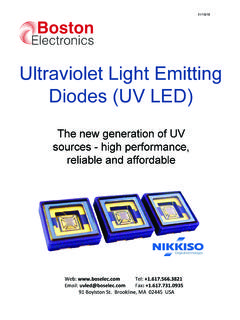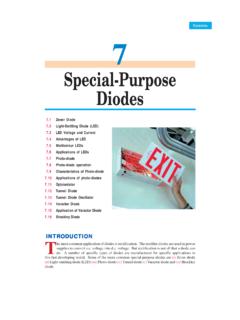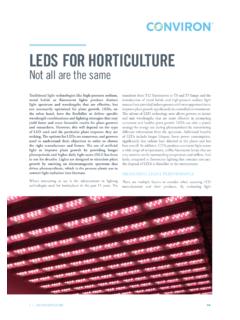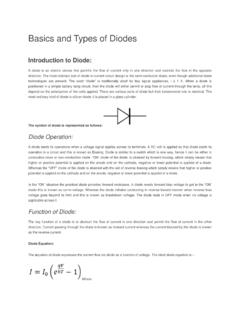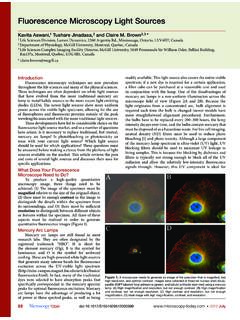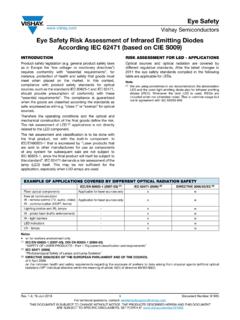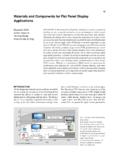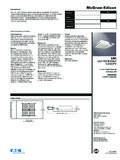Transcription of Considerations for Encapsulant Material Selection …
1 Considerations for Encapsulant Material Selection for phosphor -Converted leds December 16, 2011 Introduction: White light from light emitting Diodes ( leds ) is generated by combining blue photons from LED chips with photons of other colors from phosphor Material (s). In a direct contact layout, blue LED chips are coated with phosphors. However, since phosphors are produced as powders, most LED manufacturers use an Encapsulant Material to suspend the phosphor powder and allow for easy deposition onto the blue LED chip. In this application note, we describe the different Encapsulant requirements for various phosphor materials applications, the technical tradeoffs between Encapsulant materials, and a number of case studies illustrating how to overcome challenges for some of the most common design goals. Table of Contents Optical parameters 2 Mechanical properties 3 Chemical compatibility 5 Thermal conductivity 6 Curing 7 Case Studies 7 2 Considerations for Encapsulant Material Selection for phosphor -Converted leds December, 2011 OVERVIEW: COMMON ENCAPSULANTS AND THEIR PROPERTIES Many potential encapsulating materials, typically polymeric in nature, are commercially available with a wide variety of physical and performance characteristics.
2 An LED package designer will evaluate the performance of materials along optical, mechanical, chemical and thermal metrics, with some figures of merit bearing more importance to the overall system performance than others. The consideration of these technical parameters is necessary for all successful designs. The Material specific information contained in this application note represents the current state of the art, though the field is changing rapidly as LED package manufacturers become more and more sophisticated and demand higher performance from Encapsulant vendors. Lifetime Refractive Index Viscosity (Pa-s) Hardness Working Time, RT Dimethyl silicone 150 C, 1000 hr (98%) 35-70 JIS A Varies Phenyl silicone 150 C, 1000 hr (95%) 2-5 30-70 Shore D 25-60 JIS A Varies Epoxy 150 C, 500 hr ~90 Shore D 4-8 hr Acrylic (PMMA) >2000 hr weathering test N/A 30-105 Rockwell n/a Polycarbonate 1500 hr weathering test N/A 50-120 Rockwell n/a Table 1.
3 Common encapsulants and their properties. Representative data. Specific grades may vary. OPTICAL PARAMETERS The first design consideration is often the set of optical parameters, which include measures such as the refractive index (RI), transparency, and retention of transparency over time. Refractive Index (RI) Snell s Law tells us that as light travels through a medium, changes in the refractive index will alter the light beam s path, leading, often, to lower light extraction out of the LED package as photons become trapped reflecting around the package rather than escaping as useable light . Therefore, the ideal condition is a perfect match of the index of refraction between all optical components in the system, in order to prevent unintended reflections during both the absorption and emission steps of the phosphor down conversion process. Typically, though, the refractive index of the blue LED Material is generally around , while most phosphor materials have indices of refraction in the range and most encapsulants have RI values from to 3 Considerations for Encapsulant Material Selection for phosphor -Converted leds December, 2011 Clearly, such a perfect three-way match is impossible; nevertheless a RI of the Encapsulant on the higher end of their range does result in better light extraction, and is therefore desirable.
4 Further, the interface at the chip is much less important than the interface between the phosphor and the Encapsulant , since photons will scatter with much greater frequency between these two integrated optical components and any ability to reduce that scattering will significantly increase the photon extraction. On the other hand, most photons that reflect back to the chip are lost to heat after a single reflection, with no chance of recovery regardless of the index of refraction difference. Transparency Another optical parameter, the transparency of a Material , is simply a metric measuring the amount of photons that are lost, typically to absorption, as they travel through the Material . As one might imagine, the higher the transparency of an Encapsulant , the less it gets in the way of useable light escaping from the LED package. In the ideal case, an Encapsulant Material is 100% transparent to visible light .
5 Retention of Transparency over Time Retention of transparency over time is often far more important than the initial transparency of a Material . This requirement is particularly acute for many LED manufacturers that seek to achieve at least 70% of their light output for a minimum of 25,000 hours of operation, due to Energy Star or other industry standards Generally, the transparency over time parameter is the one given the most weight in Encapsulant Selection , and it is the one reason that dimethyl silicones have found widespread adoption despite having a refractive index closer to Phenylmethyl silicones have a higher RI, around , but often show yellowing during aging, which both reduces the light output and shifts the color point of the white light . The tradeoff of higher RI for yellowing with age may be acceptable in certain high performance packages, which are closely monitored and replaced before the performance degrades, or, separately, in packages that are not expected to have a long operating life, or where initial package brightness is a high priority.
6 MECHANICAL PROPERTIES The mechanical properties of encapsulants serve a key function to protect the LED assembly from the outside environment. This is generally a balancing act between rigidity and elasticity, where weak wire connections and the rest of the assembly need protection from external forces while the system needs to have the ability to flex with thermal expansions and contractions without generating cracks where light is lost to scattering. Epoxy encapsulants were widely used in low power leds during the infancy of the LED lighting industry, but they have not shown high resiliency as today s high power (high brightness) leds have generated more and more heat. For this reason, epoxy encapsulants have generally been replaced by the more forgiving elastic silicones. 4 Considerations for Encapsulant Material Selection for phosphor -Converted leds December, 2011 Other mechanical properties of encapsulants that are important to consider include properties of the Encapsulant before curing, as well as the cure parameters.
7 The requirements for these curing related properties will vary greatly depending on the LED packaging process, though the uncured mechanical property of greatest interest (uncured chemical properties will be addressed later in this note) is the viscosity. Typical LED phosphors vary in particle size from 4 microns to 30 microns in diameter and in density from g/cm3 to 6 g/cm3. It is necessary for the phosphor to maintain a uniform mixture within the Encapsulant from the time of mixing through deposition and final cure. For example, if phosphor particles settle during the deposition process, it is likely that there will be a wide distribution of color points formed, typically by spreading out the color point of the final product from the center point of the white color bin towards the upper right and lower left corners of the bin (see Chart 1). In fact, excessive settling could even shift the color point of the LED package away from pure white, resulting in greenish or pinkish tints in portions of the lot.
8 Another consideration is differential settling in phosphor blends formed for warm white or high CRI products. Phosphors in the red nitride family tend towards the lower end of the density range, while the yellow and green phosphors with which they are blended tend towards the higher end of the density range. Differential settling can result in shifting of the color point of the products from the upper left to the lower right within the bin or even out of the bin (see Chart 2). phosphor Settling CIE 1931 Chart 1. If phosphor particles settle during the deposition process, a wide distribution of color points is formed from the upper right to the lower left corners of the bin Dense phosphor settles to bottom of deposition mechanism - + + - 5 Considerations for Encapsulant Material Selection for phosphor -Converted leds December, 2011 Differential phosphor Settling CIE 1931 Chart 2.
9 Differential settling can result in shifting of the color point of the products from the upper left to the lower right within the bin or even out of the bin While a high viscosity Encapsulant would seem to be desired to prevent settling, it turns out a higher viscosity typically implies longer preprocessing times with slower depositions, so these two requirements must be balanced. The cure time (or pot time) is also important, as a change in viscosity during the packaging/deposition can change the amount of phosphor and Encapsulant deposited, mimicking the product distribution/spread outlined in the case of single particle settling outlined above. Architecture will also factor in; for example, higher viscosity is necessary for wide area chip-on-board applications compared to traditional chip in cup packages. CHEMICAL COMPATIBILITY Another important consideration is the chemical compatibility of the Encapsulant with the system.
10 All phosphors exhibit some susceptibility to moisture, acids and oxidizers, though the extent of susceptibility depends on the family of phosphor . Phosphors are susceptible to degradation through failures either in the host Material , such as a Silicate or a Nitride, or in the chromophore, which is to say, typically the rare earth element responsible for the electronic structure that makes down conversion possible. Silicates, due to the higher porosity of the orthosilicate structure and the stability of the active, divalent europium state relative to the inactive trivalent state, are the most susceptible. Nitrides and oxynitrides have a more robust Higher density phosphor settles to bottom of deposition mechanism + + - - 6 Considerations for Encapsulant Material Selection for phosphor -Converted leds December, 2011 crystal host, but still are susceptible to europium oxidation. Garnets and aluminates have robust crystal hosts and the trivalent cerium chromophore is less susceptible to further oxidation making them the least susceptible to the environment.

